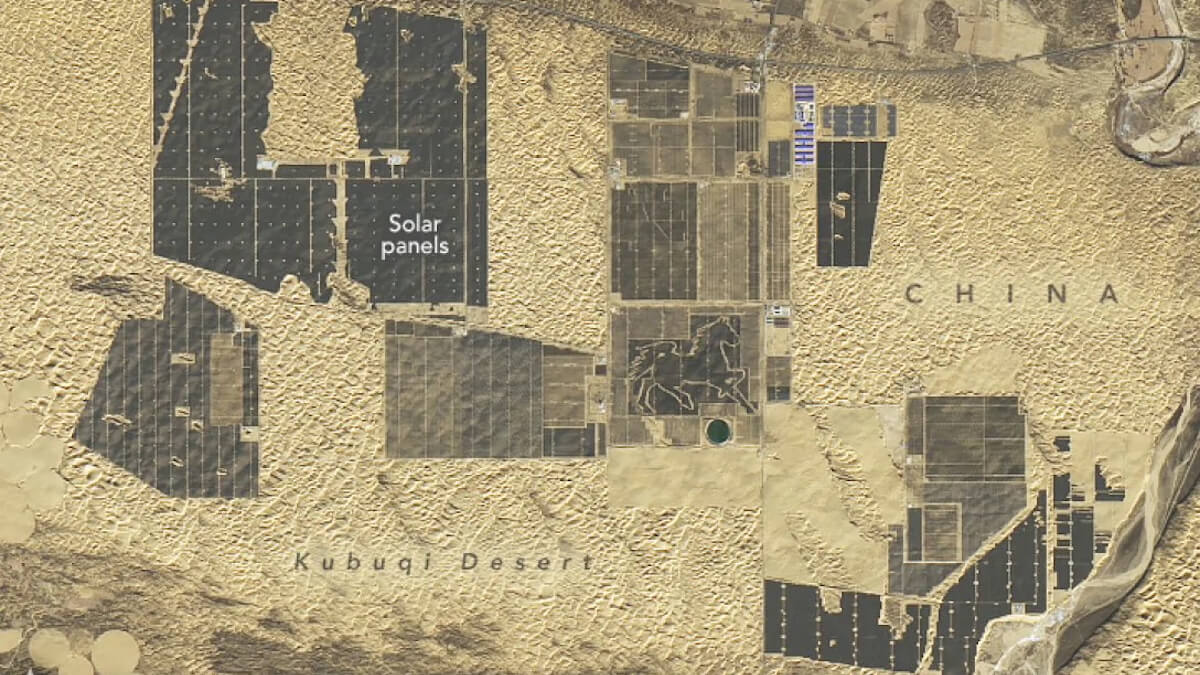The contribution China is building “Great Solar Wall” with an output of 100 nuclear power plants by Felix Baumann first appeared on Basic Thinking. You always stay up to date with our newsletter.

China is currently building a 400-kilometer “large solar wall”. It is said to have an output of around 100 nuclear power plants and is even recognizable from space.
China is currently building a “large solar wall” in the Kubuqi desert in the inner Mongolia. The gigantic Solar power plant should be completed by 2030 and achieve an output of 100 gigawatts. The solar wall is part of a large-scale project for the energy transition in China and is said to supply millions of people with electricity.
The solar power plant is to be completed over a length of 400 kilometers and an average width of five kilometers. Several gigawatts of power have already been installed. Among them: A facility with two gigawatts by the state energy group China Three Gorges and the 300 megawatt “Junma Solar Power Station”, which was built in the form of a horse.
Large solar wall is supposed to drive fossil freedom in China
According to NASA satellite images, the once hostile Kubuqi desert, which was previously considered the “sea of death”, turned into a huge solar landscape. The climatic conditions appear ideal there: lots of sunshine, flat terrain and the proximity to large industrial centers.
China is by far the largest producer of solar modules. The country produces around 1,000 gigawatts of solar panels every year. This corresponds to the performance of 1,000 nuclear power plants. The “large solar wall” is just another example of China’s endeavor to establish itself as the market leader in the field of renewable energies.
While Europe and the USA still have to struggle with the switch to green energy, China is massively investing in solar and wind energy. The “large solar wall” is said to be a symbol of the change from fossil fuels towards climate-neutral energy production.
Performance of 100 nuclear power plants
Should China achieve its goal, the “large solar wall” could play a central role in global energy supply. With an output of 100 gigawatts, it should create more electricity than many small countries. The performance should roughly correspond to that of 100 nuclear power plants.
But there are also challenges: the network operators must first optimize their power grids for storing and transporting the huge amounts of energy. China therefore plans to expand high-voltage equal current lines in order to transport the electricity without loss over long distances.
The “big solar wall” shows that China not only relies on renewable energies, but also expands them in an order of magnitude that is unparalleled worldwide. If the project is successful, it could usher in a new era of global energy supply – with China as a leading force.
Also interesting:
- Half leader of the century: Halogenid-Perskit should make solar cells cheaper
- Network overload from photovoltaic systems? Solar association cleans up with myth.
- German researchers develop tandem solar cells with record efficiency
- Inspiration Photosynthesis: Artificial Solar Bling transforms CO2 into fuel
The contribution China is building “Great Solar Wall” with an output of 100 nuclear power plants by Felix Baumann first appeared on Basic Thinking. Follow us too Google News and Flipboard.
As a Tech Industry expert, I find China’s initiative to build a “large solar wall” with an output equivalent to 100 nuclear power plants to be a significant and innovative step towards sustainable energy production. This project showcases China’s commitment to transitioning towards renewable energy sources and reducing its reliance on fossil fuels.
The scale of this solar wall is truly impressive and demonstrates the potential for solar energy to meet a significant portion of the world’s energy needs. By harnessing the power of the sun, China is not only reducing its carbon footprint but also contributing to global efforts to combat climate change.
This project also highlights the advancements in solar technology and the increasing efficiency of solar panels. As the cost of solar energy continues to decrease and the technology continues to improve, we can expect to see more large-scale solar projects like this being implemented around the world.
Overall, I believe that China’s “large solar wall” is a game-changer in the renewable energy industry and sets a positive example for other countries to follow suit in transitioning towards a more sustainable future.
Credits